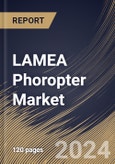Phoropters are increasingly integrated with smart technologies, enabling connectivity and data-sharing capabilities. This integration facilitates a streamlined workflow, allowing eye care professionals to access patient data, customize examinations, and enhance efficiency. The advent of telemedicine has influenced the market, enabling remote refraction services. Portable and connected phoropters allow for virtual refraction, bringing eye care services to individuals in remote locations or those unable to visit a physical clinic.
Furthermore, customization is a prevailing trend in the market, focusing on tailoring vision correction to individual patient needs. Phoropters equipped with advanced software allow for personalized assessments, considering factors such as lifestyle, occupation, and visual preferences. Incorporating wavefront technology in phoropters enables a more nuanced assessment of optical aberrations. This technology enhances diagnostic capabilities and corrects higher-order aberrations for optimized visual outcomes. Modern phoropters prioritize patient comfort and engagement. Features such as touchscreen interfaces, dynamic charts, and immersive visuals contribute to a more engaging and comfortable experience for patients undergoing refraction examinations.
In addition, the aging demographic in Brazil is likely to lead to a surge in the demand for eye care services. Older individuals often require more frequent eye examinations to monitor and address age-related vision changes. Phoropters are essential in these examinations for determining the correct prescription for eyeglasses. As per the data published in 2022 by the Pan American Health Organization, Brazil's elderly comprise over 30 million individuals, or 13 percent of the country's total population, aged 60 or greater. By the year 2030, this age group will account for 24 percent of the total population of Brazil, which is equivalent to around 50 million people. Thus, the rising aging population and eye disorders in the LAMEA region will lead to increased growth in the regional market.
The Brazil market dominated the LAMEA Phoropter Market, by Country in 2022, and would continue to be a dominant market till 2030; thereby, achieving a market value of $3,786 Thousands by 2030. The Argentina market is exhibiting a CAGR of 6.5% during (2023 - 2030). Additionally, The UAE market would experience a CAGR of 5.6% during (2023 - 2030).
Based on Product Type, the market is segmented into Automated, and Manual. Based on End User, the market is segmented into Ophthalmic Clinics, Hospitals, and Others. Based on countries, the market is segmented into Brazil, Argentina, UAE, Saudi Arabia, South Africa, Nigeria, and Rest of LAMEA.
List of Key Companies Profiled
- Topcon Corporation
- Nidek Co., Ltd.
- Reichert, Inc. (Ametek, Inc.)
- Carl Zeiss AG
- EssilorLuxottica SA (Essilor Instruments USA)
- Visionix Ltd.
- Alcon, Inc.
- bon Optic Vertriebsgesellschaft mbH.
- Hoya Corporation
- US Ophthalmic, LLC
Market Report Segmentation
By Product Type (Volume, units, USD Million, 2019-2030)- Automated
- Manual
- Ophthalmic Clinics
- Hospitals
- Others
- Brazil
- Argentina
- UAE
- Saudi Arabia
- South Africa
- Nigeria
- Rest of LAMEA
Table of Contents
Companies Mentioned
- Topcon Corporation
- Nidek Co., Ltd.
- Reichert, Inc. (Ametek, Inc.)
- Carl Zeiss AG
- EssilorLuxottica SA (Essilor Instruments USA)
- Visionix Ltd.
- Alcon, Inc.
- bon Optic Vertriebsgesellschaft mbH.
- Hoya Corporation
- US Ophthalmic, LLC
Methodology

LOADING...








